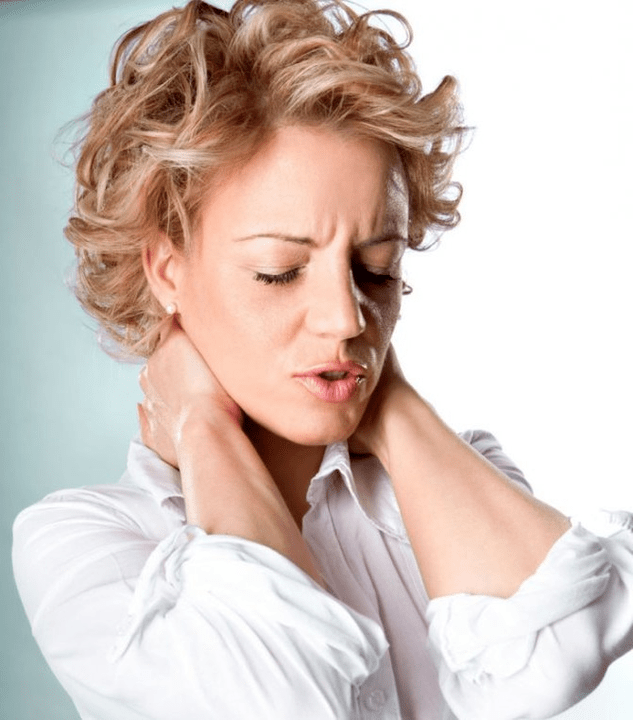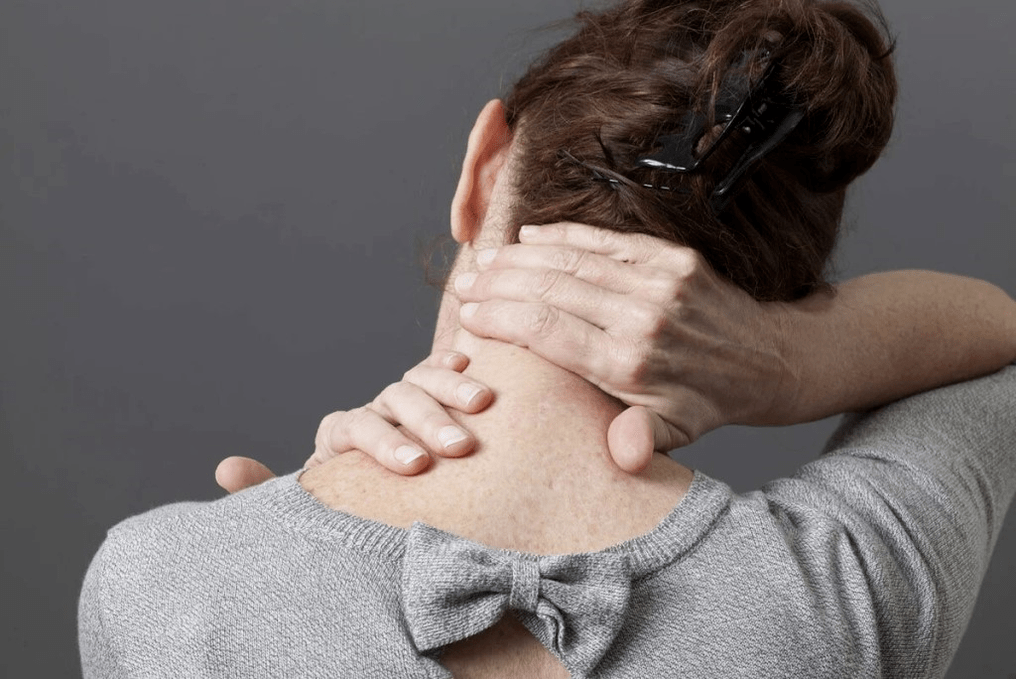
neck pain(Neck pain) is pain of varying nature and intensity that occurs in the neck area.Symptoms include dizziness, numbness in the back of the head or arms, and local skin redness and swelling.After being forced into uncomfortable positions for a long period of time, the neck can become injured due to infectious and inflammatory diseases in the area, spinal injuries, and degenerative processes.To determine the cause of neck pain, CT, MRI, ultrasound, and laboratory tests are performed.Use analgesics, NSAIDs, and physical therapy to relieve symptoms.
General characteristics
70% of adults experience neck pain on a regular basis.These sensations can vary in intensity and duration: from short-term discomfort to severe pain that makes daily activities difficult.More commonly, neck pain is localized to the cervical spine or anterolateral surface.Often, patients experience sudden "lower back pain" that is then replaced by persistent pain.The nature of the pain varies - throbbing, stinging, squeezing.They can radiate to the shoulder, scapula, and occipital areas.
The unpleasant sensation is intensified when turning and tilting the head, so the person is forced to turn the entire body.Usually, pain in the neck begins after being in an uncomfortable position for a long time: patients note that this discomfort occurs after a day of working at a computer or sewing machine.Many patients associate the onset of neck pain with the effects of hypothermia and airflow.If your neck pain is severe or if the pain is accompanied by dizziness, numbness in the back of your head, or ringing in your ears, you should seek qualified medical help as soon as possible.
Classification
Depending on the duration of the neck pain, there is acute neck pain that lasts up to 10 days, and there is chronic neck pain that is persistent or recurring.Neck pain can be divided into two forms based on the cause:
- vertebral neck pain.Occurs due to primary damage to the osteochondral structures of the cervical spine.This group includes discogenic neck pain associated with bone injury and spinal cord compression, as well as discogenic neck pain caused by disc deformation.
- nonvertebral neck pain.Includes all other causes of neck pain.Unpleasant sensations may occur due to inflammatory processes of the musculoligamentous apparatus, pathologies of the internal organs (pharynx, thyroid, lymph nodes and salivary glands).
Depending on localization, pain syndromes can be distinguished in the front or side of the neck, spinal region.Also, sore throat is isolated.Neck pain radiates to adjacent anatomical areas and is divided into cervicocranial pain (pain spreading to the occipital area) and cervicobrachial pain (cervicobrachial syndrome).
Why does my neck hurt?
Causes of sore throat
A scratchy feeling in the throat is associated with colds, but the unpleasant sensation can often be caused by other causes (too dry indoor air, exposure to atmospheric pollutants).Sometimes the pain syndrome is so intense that the patient feels pain all over his or her neck.Conditions such as:
- laryngitis: Atrophic, hemorrhagic, proliferative.
- viral diseases: ARVI, infectious mononucleosis, influenza, etc.
- bacterial infection: Tonsillitis, diphtheria, scarlet fever.
- allergic inflammation: Laryngotracheitis, pharyngitis.
- There is a foreign body in the throat;Meat and fish bones for children - part of toys.
- Defect status:Lack of vitamins B12 and B2, ascorbic acid, and iron.
- Gastroesophageal reflux.
- Rare causes: Excessive styloid process, Itsenko-Cushing syndrome, malignant tumors of the throat or voice box.
Causes of pain in front of neck
Discomfort may be localized to a limited area just below the chin, but more commonly it is severe, diffuse pain.The pain worsens when swallowing, turning the head, or squeezing the neck with a shirt collar.Causes of neck pain include:
- Thyroid pathology: Acute and subacute thyroiditis, diffuse toxic goiter, Hashimoto's thyroiditis.
- Injuried: Sprains and tears of muscle fibers, blows to the neck.
- Inflammatory process:Myositis, neuritis, tendonitis.
- purulent disease: Purulent cervical cyst, peritonsillar abscess.
- Lymphoid tissue damage: Lymphadenitis, lymphangitis.
- cervical spine compression syndrome: Nerve root artery, vertebral artery.
- Related organ diseases: Esophagitis, tracheitis.
- Angina attack.

Causes of cervical pain
The patient complains of pain in the neck along its posterior surface.The pain was intense; the patient was forced to keep his head and shoulder girdle motionless due to persistent "lumbar pain."Cervical pain can be a symptom of the following pathological conditions:
- spinal degenerative disease: Cervical osteochondrosis, osteoarthritis, disc prolapse or herniation.
- bone damage: Cervical spine compression fractures, spinal cord compression, vertebral arch and vertebral process fractures.
- Damage to other buildings: The supraspinal ligament and interspinous ligament of the spine are ruptured, and the paravertebral muscles are damaged.
- systemic connective tissue disease: Ankylosing spondylitis (ankylosing spondylitis), arthritis (rheumatoid, psoriasis), Reiter's syndrome.
- infection process: Osteomyelitis, vertebral tuberculosis.
- Rare causes: Presence of pathological bilateral cervical ribs, Klippel-Feil syndrome.
Causes of side neck pain
Severe pain on one side of the neck often radiates to the shoulder or ear.A person may feel tingling, burning, or pulsing in the area.In severe discomfort, secondary torticollis will form, with the head constantly tilting to the painful side and the chin to the healthy side.The most common causes of side neck pain are:
- Vascular Pathology: Varicose veins of the neck, atherosclerosis of the carotid arteries supplying the brain.
- Always in an awkward position: Frequently lowering head when working in front of computer, poor sleeping pillow, weird gait, neck tilted in the same direction.
- muscle spasms: Violent head rotation and strenuous physical activity after hypothermia.
- Retropharyngeal abscess.
- neoplastic diseases: Tumors of the thyroid and parathyroid glands, tumors of the pharynx and lateral surface of the larynx.
- congenital disease: Grisel syndrome, winged neck with Shereshevsky-Turner anomaly.
- Rare causes: Complications after subarachnoid hemorrhage and meningitis.
diagnosis
People with neck pain most often turn to an osteopath or neurologist.The exam is long and complex; in order to make a correct diagnosis, it is necessary to rule out many causes of neck pain.Diagnostic searches involve the use of laboratory and instrumental methods aimed at visualizing the affected area and looking for signs of concomitant disease.The most informative ones are:
- Ultrasound examination.Ultrasound of the neck and other parts of the body is used to quickly and non-invasively visualize all neck structures, identifying signs of pathology in the internal organs that may cause neck pain.Targeted ultrasound examination of the thyroid and submandibular salivary glands.Duplex scanning helps assess blood flow status in large blood vessels.
- X-ray imaging.Neck radiographs are used to identify deformations of bone structures and shifting vertebrae, which can cause neck pain.A more informative method is a spine CT scan, which allows one to assess the nature and extent of spinal disease.MRI is recommended to examine the ligamentous apparatus.
- Functional diagnosis.The occurrence of neck pain may be due to damage to the muscular system, so electromyography is recommended.If radicular pain is suspected, an electroneurogram is performed.To detect cervical kyphosis, the Forestier test is performed.Pain level was determined using the McGill Questionnaire.
- laboratory methods.General and biochemical blood tests are needed to rule out acute inflammatory processes that may be causing neck pain.The concentration of thyroid hormone must be determined.In the presence of general infectious syndromes, bacterial culture and serological reactions (RIF, ELISA, PCR) of sputum or throat smears are performed.
If a patient has pain not only in their neck but also in their throat, they need to be examined by an otolaryngologist.If severe pain occurs, especially in elderly patients or those with a history of heart disease, an electrocardiogram should be recorded to rule out atypical angina and myocardial infarction.For severe spinal injuries with sensory impairment or paralysis, a myelogram may be performed to evaluate the condition of the spinal canal.
treat
Pre-diagnosis help
If your neck starts to hurt, don't delay seeing your doctor.Neck pain requires careful diagnosis to determine the cause of the uncomfortable symptoms.It is necessary to avoid sudden movements, drafts and hypothermia in the neck area.Until a diagnosis is made, neck pain can be relieved with a warming procedure (wrapping the neck with a woolen scarf).If the pain is severe, you can take an analgesic from the NSAID group.However, these drugs should not be taken long-term without a doctor's prescription because they can cause gastrointestinal ulcers and bleeding.

Conservative treatment
Medical strategies for neck pain depend on the cause of the disease and the intensity of the pain.Medication alone is rarely used; it is more effective when combined with modern physical therapy methods.To relieve neck pain and eliminate the underlying pathology causing it, the following groups of medications are used:
- NSAIDs.The drug effectively eliminates the inflammatory process and relieves pain.To reduce side effects, it is recommended to use selective COX-2 inhibitors that do not affect the gastrointestinal mucosa.
- muscle relaxants.The drug quickly eliminates muscle spasms and after relaxing the muscles, the neck pain is much reduced.Observe the effect after the first injection; to consolidate the effect, use the product during the course.
- anesthetic.For severe neck pain that the patient cannot tolerate.The medication is administered as an injection (blockade) into the affected area.Long-term use of local anesthetics is not recommended.
- antibiotic.These medications are indicated for the treatment of painful bacterial and purulent processes in the neck area.In this case, the patient's discomfort disappears when the cause is eliminated.
- vitamins.B vitamin preparations, especially thiamine, are actively used in cases of chronic pain in the neck.The drug improves nutrition of spinal roots and nerves.
physiotherapy
To eliminate muscle tension that causes neck pain, use a Shants collar, which is recommended for 2-3 weeks.After local heat therapy (mud baths and hot compresses, anesthetic electrophoresis), the neck pain was relieved.Manual therapy techniques help restore the anatomical position of the vertebrae and discs.Magnet therapy and acupuncture can help relieve chronic neck pain.After acute pain subsides, massage is initiated, and physical therapy must be supplemented by exercise therapy.
surgical treatment
For neck pain caused by spinal pathology, surgical intervention is required.To relieve pressure on the nerve roots, discectomies, foraminotomies, and laminectomies may be performed.When a hernia is detected, appropriate surgery is performed; when a tumor is detected in the cervical part of the body, it is surgically removed.Severe degenerative disease of the spine is an indication for spinal fusion.If your neck pain is caused by an ulcer or cyst, it will need to be cut and drained, and the resulting cavity cleaned with an antibacterial solution.



































